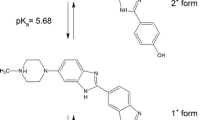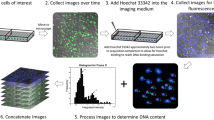Abstract
The fluorescent dye 4′-6-Diamidino-2-phenylindole (DAPI) is frequently used in fluorescence microscopy as a chromosome and nuclear stain because of its high specificity for DNA. Normally, DAPI bound to DNA is maximally excited by ultraviolet (UV) light at 358 nm, and emits maximally in the blue range, at 461 nm. Hoechst dyes 33258 and 33342 have similar excitation and emission spectra and are also used to stain nuclei and chromosomes. It has been reported that exposure to UV can convert DAPI and Hoechst dyes to forms that are excited by blue light and emit green fluorescence, potentially confusing the interpretation of experiments that use more than one fluorochrome. The work reported here shows that these dyes can also be converted to forms that are excited by green light and emit red fluorescence. This was observed both in whole tissues and in mitotic chromosome spreads, and could be seen with less than 10-s exposure to UV. In most cases, the red form of fluorescence was more intense than the green form. Therefore, appropriate care should be exercised when examining tissues, capturing images, or interpreting images in experiments that use these dyes in combination with other fluorochromes.









Similar content being viewed by others
References
Hiraoka Y, Shimi T, Haraguchi T (2002) Multispectral imaging fluorescence microscopy for living cells. Cell Struct Funct 27(5):367–374. https://doi.org/10.1247/csf.27.367
Jež M, Bas T, Veber M, Košir A, Dominko T, Page R, Rožman P (2012) The hazards of DAPI photoconversion: effects of dye, mounting media and fixative, and how to minimize the problem. Histochem Cell Biol 139(1):195–204. https://doi.org/10.1007/s00418-012-1039-8
Malik Z, Dishi M, Garini Y (1996) Fourier transform multipixel spectroscopy and spectral imaging of protoporphyrin in single melanoma cells. Photochem Photobiol 63(5):608–614. https://doi.org/10.1111/j.1751-1097.1996.tb05663.x
Piterburg M, Panet H, Weiss A (2012) Photoconversion of DAPI following UV or violet excitation can cause DAPI to fluoresce with blue or cyan excitation. J Microsc 246(1):89–95. https://doi.org/10.1111/j.1365-2818.2011.03591.x
Żurek-Biesiada D, Kędracka-Krok S, Dobrucki JW (2013) UV-activated conversion of Hoechst 33258, DAPI, and Vybrant DyeCycle fluorescent dyes into blue-excited, green-emitting protonated forms. Cytometry 83A(5):441–451. https://doi.org/10.1002/cyto.a.22260
Funding
This study was funded by the National Institute of General Medical Sciences of the National Institutes of Health (USA) under award number RO1GM065604.
Author information
Authors and Affiliations
Corresponding author
Ethics declarations
Conflict of interest
The authors declare that they have no conflicts of interest.
Ethical approval
This article does not contain any studies with human participants or vertebrate animals performed by any of the authors.
Rights and permissions
About this article
Cite this article
Karg, T.J., Golic, K.G. Photoconversion of DAPI and Hoechst dyes to green and red-emitting forms after exposure to UV excitation. Chromosoma 127, 235–245 (2018). https://doi.org/10.1007/s00412-017-0654-5
Received:
Revised:
Accepted:
Published:
Issue Date:
DOI: https://doi.org/10.1007/s00412-017-0654-5




